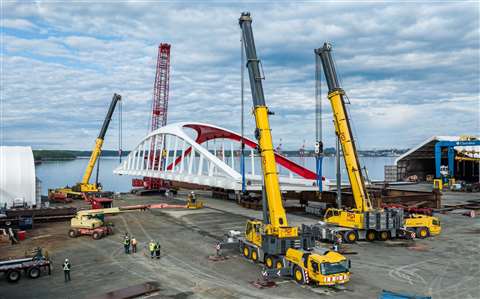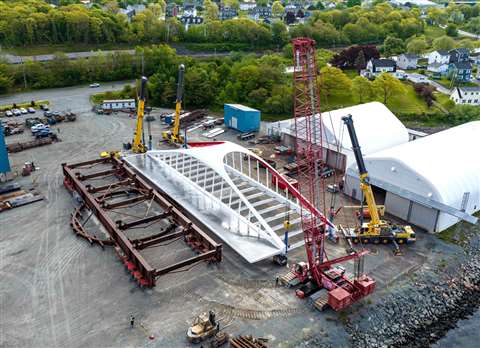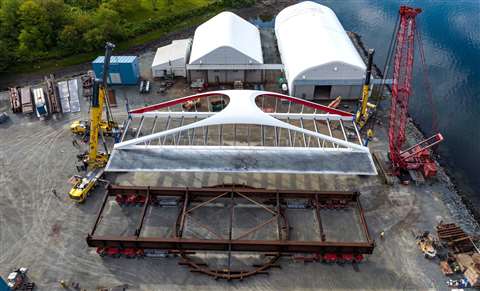R&D Crane utilizes four cranes for complex Canadian bridge lift
10 October 2022
Canada’s Cherubini Bridges and Structures has completed work on the Four Signature Bridges contract for Toronto’s Port Lands project. The company successfully orchestrated a complex four-crane pick to get the final 492-ton (446.6 tonne) segment of the bridge sent up the St. Lawrence River by barge.
 A Model 16000 crawler crane and three Grove all-terrain models combined to lift a 492-ton bridge section onto self-propelled transporter for later unloading and installation.
A Model 16000 crawler crane and three Grove all-terrain models combined to lift a 492-ton bridge section onto self-propelled transporter for later unloading and installation.
The lift of the 73-foot wide, 187-foot long (22.3 meters-wide, 57.1 meters-long) Cherry Street North Bridge was performed by R&D Crane which, like the fabricator, is a division of Cherubini Group. It was completed using the four largest cranes in its fleet: a Manitowoc Model 16000 lattice-boom crawler, and Grove GMK6400, GMK5250L and GMK5240 all-terrain models.
The cranes combined to lift the structure from its supports in the yard at Cherubini’s Pleasant Street Fabrication Facility in Dartmouth, Nova Scotia, allowing a self-propelled modular transporter (SPMT) with transfer beams and a huge Cherubini-engineered turntable to take the load. The SPMT was then driven onto a barge moored alongside the site’s dedicated harborside wharf to begin its journey to Toronto.
The need to bring together the four cranes was an engineering solution to help ensure the bridge was positioned as smoothly as possible at its final resting place, as Cherubini Group CEO, Darren Czech, explained.
 The lift was performed by R&D Crane, sister company of the fabricator and part of the Nova Scotia-based Cherubini Group.
The lift was performed by R&D Crane, sister company of the fabricator and part of the Nova Scotia-based Cherubini Group.
“Loading the bridge sections onto the barge wasn’t the issue, as the transporters were able to pick the sections and drive straight on,” said Czech. “But with this particular section, and also a second one, there were space restrictions which meant we couldn’t just simply roll on and roll off the barge using the self-propelled transporters alone. Because of the this, we engineered a solution that supplied the sections to the jobsite on a turntable structure — our giant ‘Lazy Susan.’ This allowed tugboats in Toronto to spin them around on the barge in the middle of the harbor, ideally positioning them to slot right into their final resting place. So, we used the four-crane pick at our yard to make sure the section was accurately placed on the turntable ahead of shipping to Toronto.”
For the lift, one crane was positioned at each corner of the bridge, and all were configured with main boom and partial counterweight. The 16000 had 118 feet (36 meters) of boom with 148 tons (134 tonnes) of rear counterweight and 30 tons (27 tonnes) of carbody counterweight. All three Groves maximized their outrigger deployment, with the GMK6400 working with 105 tons (95 tonnes) of counterweight and 66 feet (20 meters) of boom; the GMK5250L working with 77 tons (70 tonnes) counterweight and 77 feet (23.5 meters) of boom; and the GMK5240 working with 49 tons (44 tonnes) counterweight and 75 feet (23 meters) of boom.
 The lift was completed seamlessly within four hours, with the cranes and their operators working in total harmony, the company said.
The lift was completed seamlessly within four hours, with the cranes and their operators working in total harmony, the company said.
“The lift went without a hitch, taking less than four hours,” said Rob Blois, general manager, R&D. “Although the cranes were mobilized roughly a week prior to help with planning, setting up mats, and finalizing onsite details. The key was really the planning — working out how to maintain equal weights during the lift and spreading the load to reduce ground-bearing pressure. But on the day the cranes worked very well together. We have a full fleet of Manitowoc and Grove machines, which minimizes the mechanical and operational challenges a mixed fleet can cause.”
STAY CONNECTED


Receive the information you need when you need it through our world-leading magazines, newsletters and daily briefings.




